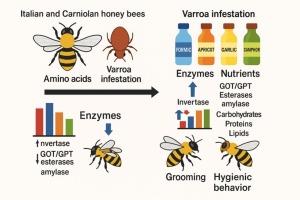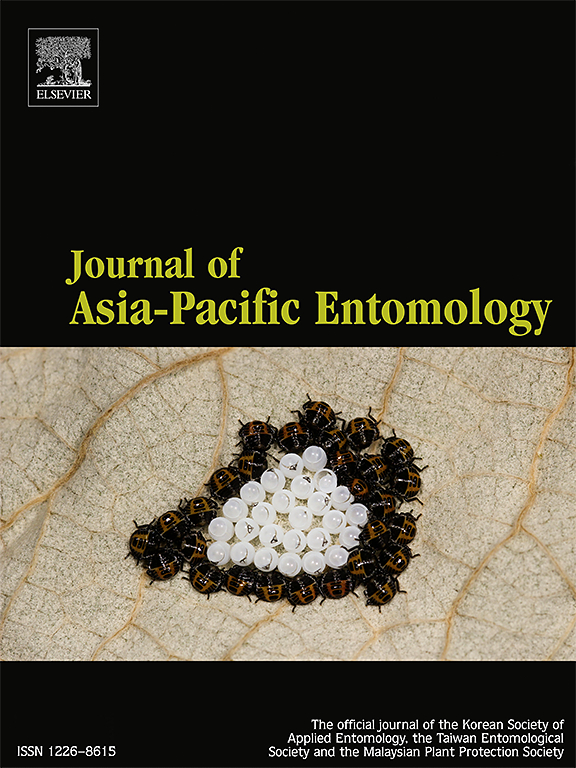灭螨害虫和植物油对意大利和意大利蜜蜂生理特性及防御行为机制的影响
IF 1.3
3区 农林科学
Q3 ENTOMOLOGY
引用次数: 0
摘要
研究了意大利蜜蜂和卡尼奥兰蜜蜂(Apis mellifera)对植物处理和灭蟑的生理和行为反应。氨基酸分布、酶活性、营养成分、梳理和卫生习惯的测量被用来评估侵染和处理(甲酸、杏籽提取物、大蒜油和樟脑油)的效果。在这两个蜜蜂亚种中,瓦螨侵染显著改变了氨基酸水平,特别是降低了脯氨酸、丙氨酸和蛋氨酸。未感染的蜜蜂体内必需氨基酸水平较高,而服用甲酸的蜜蜂体内蛋氨酸和谷氨酸水平较高。一般来说,杏油中氨基酸的浓度最低。未经处理的对照组的总碳水化合物、蛋白质和脂质含量最高,而用大蒜油或甲酸处理的蜜蜂的碳水化合物、蛋白质和脂质含量最低。杏油处理的蜜蜂的转化酶活性最高,而甲酸和大蒜油处理的蜜蜂的GOT、GPT、淀粉酶和酯酶活性则下降。意大利和卡尼奥兰蜜蜂的酶水平各不相同,后者通常表现出更大的活性。根据行为分析,在治疗后的五天内,梳理的反应发生了变化。杏提取物和大蒜油显著影响了蜂群的梳理行为,在最初的24小时内观察到最高的卫生行为。这些发现表明,瓦罗亚侵染损害了蜜蜂的生理机能,但某些植物处理,特别是杏和大蒜油,可能通过改善生化平衡和行为防御来增强蜜蜂的恢复力。本文章由计算机程序翻译,如有差异,请以英文原文为准。

The effects of Varroa destructor infestation and botanical oils on physiological characteristics and mechanism of defensive behavior of Carniolan and Italian Apis mellifera
The purpose of this study was to assess the physiological and behavioral reactions of Italian and Carniolan honey bees (Apis mellifera) to botanical treatments and infestations of Varroa destructor. Measurements of amino acid profiles, enzyme activities, nutrient contents, grooming, and hygienic practices were used to evaluate the effects of infestation and treatments (formic acid, apricot seed extract, garlic oil, and camphor oil). In both bee subspecies, Varroa mite infestation markedly changed the levels of amino acids, especially lowering proline, alanine, and methionine. Essential amino acid levels were higher in uninfested bees, whereas methionine and glutamic acid levels were higher in bees treated with formic acid. In general, the lowest concentrations of amino acids were found in apricot oil. The untreated controls had the highest levels of total carbohydrates, proteins, and lipids, while the bees treated with garlic oil or formic acid had the lowest levels. While invertase activity peaked in bees treated with apricot oil, the enzymatic activities of GOT, GPT, amylase, and esterases decreased when exposed to formic acid and garlic oil. The enzyme levels of Italian and Carniolan bees varied, with the latter typically exhibiting greater activity. Grooming responses changed over five days after treatment, according to behavioral assays. Apricot extract and garlic oil significantly influenced grooming behavior in colonies, with the highest levels of hygienic behavior observed within the first 24 h. These findings suggest Varroa infestation impairs bee physiology, but certain botanical treatments especially apricot and garlic oils may enhance bee resilience through improved biochemical balance and behavioral defenses.
求助全文
通过发布文献求助,成功后即可免费获取论文全文。
去求助
来源期刊

Journal of Asia-pacific Entomology
Agricultural and Biological Sciences-Insect Science
CiteScore
2.70
自引率
6.70%
发文量
152
审稿时长
69 days
期刊介绍:
The journal publishes original research papers, review articles and short communications in the basic and applied area concerning insects, mites or other arthropods and nematodes of economic importance in agriculture, forestry, industry, human and animal health, and natural resource and environment management, and is the official journal of the Korean Society of Applied Entomology and the Taiwan Entomological Society.
 求助内容:
求助内容: 应助结果提醒方式:
应助结果提醒方式:


